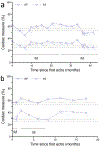Cardiac Function in Children and Young Adults Treated with MEK Inhibitors: A Retrospective Cohort Study
- PMID: 35233653
- PMCID: PMC10284303
- DOI: 10.1007/s00246-022-02842-y
Cardiac Function in Children and Young Adults Treated with MEK Inhibitors: A Retrospective Cohort Study
Abstract
MEK inhibitors (MEKi) have shown efficacy in pediatric low-grade glioma as well as plexiform neurofibroma. MEKi have been associated with acute cardiac dysfunction in adults. Cardiac consequences in children are unknown. We performed a single center retrospective cohort study evaluating cardiac function by echocardiography (echo) in children and young adults < 21 years receiving MEKi between October 2013 and May 2018. Blinded assessment of left ventricular function by fractional shortening (FS) and ejection fraction (EF) was performed on all available echocardiograms performed before, during, and following therapy, as well as after re-initiation of therapy. Twenty-six patients underwent MEKi therapy with echo follow-up during the study period. Twenty-four of these had complete echo data. Median follow-up was 12 months. Borderline EF (EF 53-57.9%) occurred in 12 (50%) patients; and 3 (12.5%) progressed to abnormal EF (EF < 53%). Cardiac dysfunction, when it occurred, was mild (lowest documented EF was 45%, and lowest FS was 24.4%). EF abnormalities typically fluctuated during therapy, resolved off therapy, and recurred with MEKi re-initiation. No clinical or demographic differences were detected between those who maintained normal cardiac function and those who developed borderline or overt cardiac dysfunction. Symptomatic heart failure did not occur. In this cohort of children and young adults, MEKi use was associated with a high (50%) incidence of borderline or mildly decreased left ventricular function. There was no evidence of permanent cardiac dysfunction. Further evaluation in larger prospective trials is needed.
Keywords: Echocardiography; Low-grade glioma; MEK inhibitor; Pediatrics; Ventricular dysfunction.
© 2022. The Author(s), under exclusive licence to Springer Science+Business Media, LLC, part of Springer Nature.
Conflict of interest statement
Figures


References
-
- Fangusaro J, Onar-Thomas A, Young Poussaint T, et al. (2019) Selumetinib in paediatric patients with BRAF-aberrant or neurofibromatosis type 1-associated recurrent, refractory, or progressive low-grade glioma: a multicentre, phase 2 trial. Lancet Oncol 20:1011–1022. 10.1016/S1470-2045(19)30277-3 - DOI - PMC - PubMed
MeSH terms
Substances
Grants and funding
LinkOut - more resources
Full Text Sources
Medical

